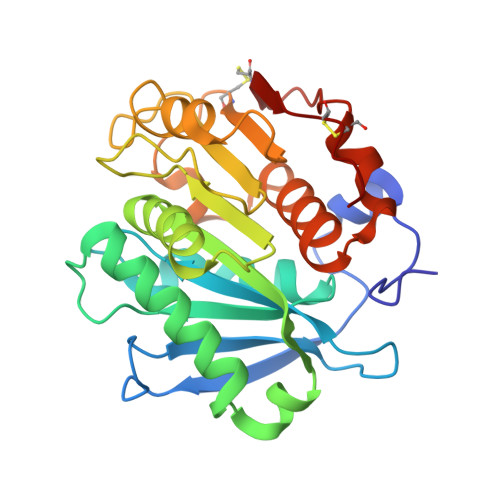Structural basis of mutants of PET-degrading enzyme from Saccharomonospora viridis AHK190 with high activity and thermal stability.
Emori, M., Numoto, N., Senga, A., Bekker, G.J., Kamiya, N., Kobayashi, Y., Ito, N., Kawai, F., Oda, M.(2021) Proteins 89: 502-511
- PubMed: 33340163
- DOI: https://doi.org/10.1002/prot.26034
- Primary Citation of Related Structures:
7CTR, 7CTS - PubMed Abstract:
The cutinase-like enzyme from the thermophile Saccharomonospora viridis AHK190, Cut190, is a good candidate to depolymerize polyethylene terephthalate (PET) efficiently. We previously developed a mutant of Cut190 (S226P/R228S), which we designated as Cut190* that has both increased activity and stability and solved its crystal structure. Recently, we showed that mutation of D250C/E296C on one of the Ca 2+ -binding sites resulted in a higher thermal stability while retaining its polyesterase activity. In this study, we solved the crystal structures of Cut190* mutants, Q138A/D250C-E296C/Q123H/N202H, designated as Cut190*SS, and its inactive S176A mutant, Cut190*SS_S176A, at high resolution. The overall structures were similar to those of Cut190* and Cut190*S176A reported previously. As expected, Cys250 and Cys296 were closely located to form a disulfide bond, which would assuredly contribute to increase the stability. Isothermal titration calorimetry experiments and 3D Reference Interaction Site Model calculations showed that the metal-binding properties of the Cut190*SS series were different from those of the Cut190* series. However, our results show that binding of Ca 2+ to the weak binding site, site 1, would be retained, enabling Cut190*SS to keep its ability to use Ca 2+ to accelerate the conformational change from the closed (inactive) to the open (active) form. While increasing the thermal stability, Cut190*SS could still express its enzymatic function. Even after incubation at 70°C, which corresponds to the glass transition temperature of PET, the enzyme retained its activity well, implying a high applicability for industrial PET depolymerization using Cut190*SS.
Organizational Affiliation:
Graduate School of Life and Environmental Sciences, Kyoto Prefectural University, Kyoto, Japan.

















